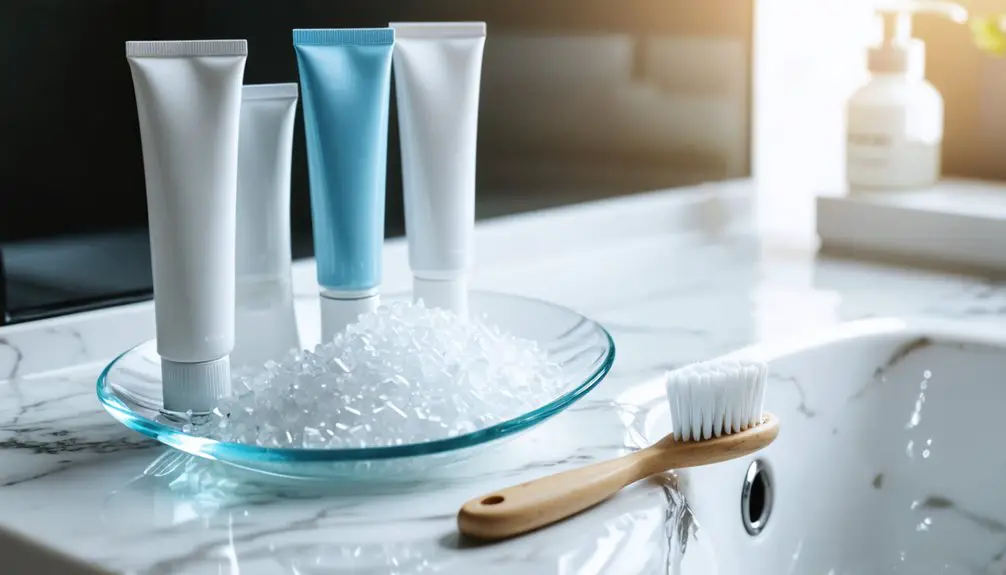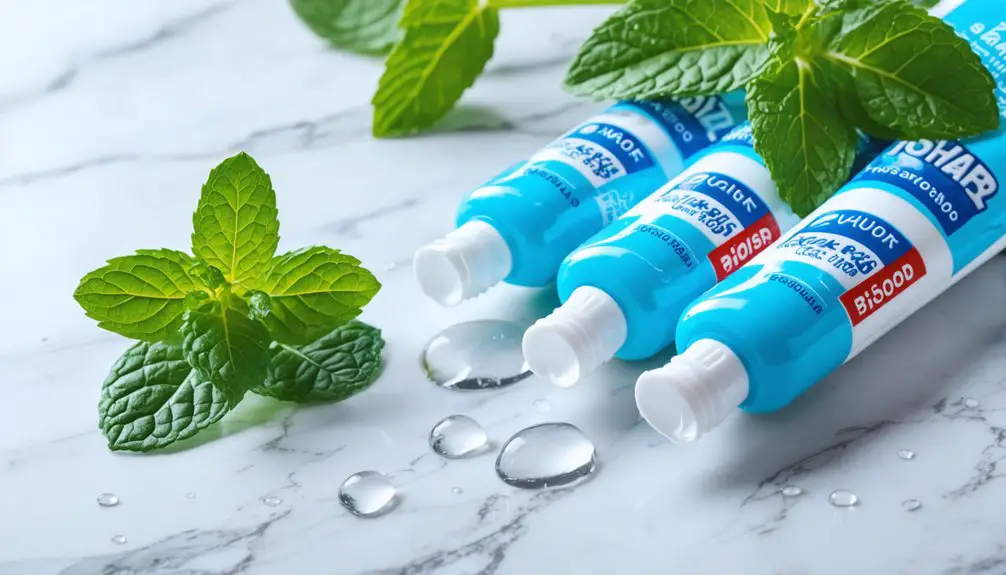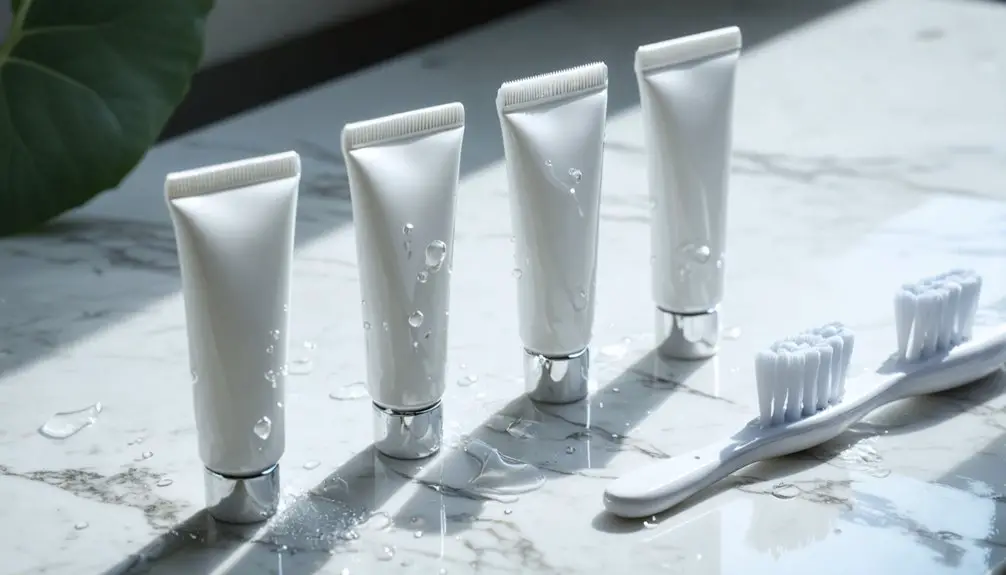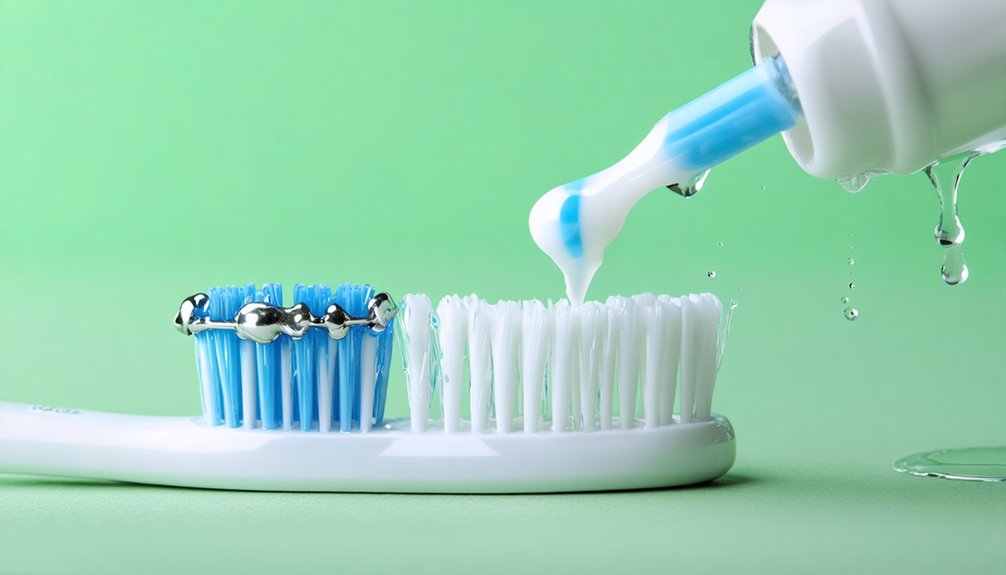To effectively remove plaque while whitening, select toothpaste containing both sodium fluoride and gentle abrasives like hydrated silica. You’ll need to brush for a full two minutes using the Modified Bass technique, positioning your brush at a 45-degree angle to your gumline with gentle circular motions. Balance whitening power with enamel protection by choosing pH-balanced formulations with moderate RDA scores and avoiding harsh abrasives. Discover how specific ingredients and proper technique can transform your oral care routine.
Key Takeaways
- Use a whitening toothpaste with sodium fluoride and mild abrasives like hydrated silica for effective plaque removal and enamel protection.
- Brush for a full two minutes using gentle circular motions at a 45-degree angle to maximize plaque disruption.
- Choose pH-balanced whitening formulations containing zinc compounds to inhibit plaque-forming bacteria while protecting enamel.
- Divide mouth into quadrants and start brushing at different locations each session to ensure thorough plaque removal.
- Select clinically proven whitening toothpastes with moderate RDA scores to prevent enamel damage while removing stains.
Choose the Right Active Ingredients for Maximum Plaque Control

When selecting a whitening toothpaste for plaque control, you’ll need to focus on specific active ingredients that work together to combat oral bacteria and prevent tartar buildup.
Look for products containing sodium fluoride or stannous fluoride, as these provide essential fluoride benefits, including enamel remineralization and protection against acid attacks. The bacteria in plaque can feed on leftover sugars to produce harmful acids that damage your tooth enamel.
Choosing a fluoride-based toothpaste strengthens tooth enamel and creates a protective barrier against harmful acids that cause decay.
Include zinc compounds in your selection criteria, as they effectively inhibit bacterial enzymes that lead to plaque formation. The combination of zinc citrate with fluoride creates a powerful defense system against oral bacteria. Surfactant compounds like sodium lauryl sulphate help dislodge and remove stubborn plaque deposits.
For enhanced results, choose formulations that contain pyrophosphates or sodium hexametaphosphate, which prevent plaque from hardening into tartar. These ingredients work alongside mild abrasives like hydrated silica, which physically removes surface plaque while the active ingredients provide ongoing protection.
Master Your Daily Brushing Technique
Having the right whitening toothpaste with effective ingredients won’t yield ideal results without proper brushing technique. To maximize plaque removal, adopt the Modified Bass technique by positioning your brush at a 45-degree angle to your gumline and making gentle circular motions. Regular brushing with dentifrice improves cleaning effectiveness by approximately 20% compared to using water alone. Research shows that two-minute brushing sessions remove significantly more plaque than one-minute sessions.
You’ll need to maintain technique consistency for at least two minutes, twice daily.
Divide your mouth into quadrants and systematically clean all surfaces – occlusal, buccal, and lingual – using a soft-bristled brush with moderate pressure (about 200g). Avoid horizontal scrubbing, which can damage your enamel and gums.
Remember that brushing duration matters considerably; shorter sessions won’t effectively disrupt plaque buildup. Start at different locations each time to prevent habitually missing certain areas, and pay special attention to hard-to-reach posterior teeth and inner surfaces.
Balance Whitening Power With Enamel Protection
Although whitening toothpaste can effectively remove surface stains, selecting the right formulation requires careful consideration of enamel protection.
Recent studies show that extended brushing cycles with commercial whitening toothpaste can increase enamel roughness by up to 66%.
To maintain enamel safety while achieving whitening effectiveness, look for products with controlled concentrations of hydrogen peroxide and enzyme-based ingredients like papain and bromelain.
Safe whitening requires toothpaste with carefully balanced peroxide levels and natural enzymes like papain and bromelain for gentle stain removal.
Choose toothpaste with moderate RDA scores and pH-balanced formulations to prevent long-term enamel roughness. The presence of fluoride, along with calcium and phosphate compounds, helps strengthen your enamel during the whitening process.
Consider clinically proven options like Crest 3D White that balance stain removal with enamel protection. For optimal results, brush teeth at least twice daily to maintain consistent whitening effects.
You’ll achieve excellent results by avoiding highly abrasive formulations that can increase sensitivity and decay risk. Instead, opt for products containing mild abrasives like calcium carbonate, which both cleans and reinforces enamel structure.
Frequently Asked Questions
Can Whitening Toothpaste Remove Coffee Stains From Dental Crowns or Veneers?
No, whitening toothpaste can’t remove coffee stains from your dental restorations. You’ll need professional dental cleaning services for effective coffee stain removal and proper dental restoration care.
How Long Should I Wait After Eating Before Using Whitening Toothpaste?
You don’t need to wait after eating to use whitening toothpaste, but following standard timing guidelines, it’s best to brush 30 minutes after meals to protect enamel from acid exposure.
Is It Safe to Use Whitening Toothpaste With Braces?
Like a gentle breeze, whitening toothpaste can be safe with braces if you choose non-abrasive formulas. For proper braces care and enamel safety, consult your orthodontist first to guarantee even whitening results.
Can Children Use Whitening Toothpaste for Plaque Removal?
You shouldn’t use whitening toothpaste for children’s dental health, as it’s too abrasive for developing teeth. Instead, choose age-appropriate fluoride toothpaste and focus on proper brushing technique for plaque removal.
Should Whitening Toothpaste Be Used Before or After Using Mouthwash?
Use whitening toothpaste before mouthwash to maximize whitening benefits. This sequence allows the toothpaste’s active ingredients to work effectively, while mouthwash’s protective qualities provide a final cleansing and freshening effect.
References
- https://smilesonic.com/whitening-toothpaste-can-it-be-used-daily-to-maintain-a-bright-smile/
- https://pmc.ncbi.nlm.nih.gov/articles/PMC9600486/
- https://www.gpdentalteam.com/2025/08/how-does-teeth-whitening-toothpaste-work/
- https://pmc.ncbi.nlm.nih.gov/articles/PMC6369603/
- https://www.goodrx.com/conditions/dental-care/best-whitening-toothpaste
- https://www.schwimmerdental.com/blog/best-toothpaste-for-plaque-removal
- https://www.kwcdental.com/blog/best-toothpaste-for-gum-disease
- https://www.dentalcare.com/en-us/ce-courses/ce565/tartar-control
- https://www.dentalcare.com/en-us/ce-courses/ce565/anti-gingivitis-active-ingredients
- https://shop.colgate.com/products/colgate-total-plaque-pro-release-whitening-toothpaste-3-oz-tube



